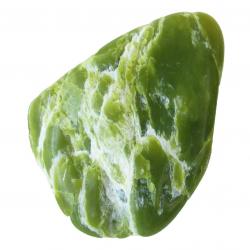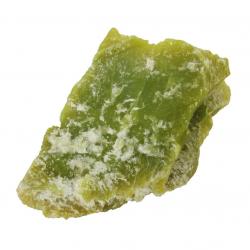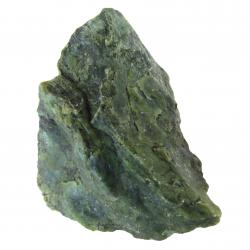Sign up for Lesson Plans, discounts & more!
Serpentine
Serpentine, a hydrous magnesium silicate mineral, is a highly intriguing and complex geological specimen. Its chemical formula is typically represented as (Mg,Fe,Ni,Al)3(Si,Al)2O5(OH)4, reflecting its variability in cation composition. The proportion of magnesium, iron, nickel, and aluminum may differ among individual serpentine samples, resulting in a diverse range of mineral compositions within the serpentine group.
From a crystallographic perspective, serpentine is classified as a phyllosilicate mineral due to its sheet-like structure. It belongs to the monoclinic or orthorhombic crystal system and exhibits a lamellar or fibrous habit. The fibers can form convoluted masses or even intricate pseudomorphs after other minerals, adding to its visual appeal.
In terms of physical properties, serpentine has a relatively low hardness, typically ranging from 2.5 to 4 on the Mohs scale. This softness makes it susceptible to scratching and abrasion. However, despite its low hardness, serpentine displays an excellent toughness and durability, further enhanced by its fibrous and scaly texture.

Serpentine deposits are commonly associated with regions of serpentinization, a geological process wherein ultramafic rocks are transformed through hydration and metamorphism. These rocks, rich in magnesium and iron, undergo reaction with water and carbon dioxide at high temperatures and pressures, leading to the formation of serpentine minerals. This process is often observed in areas with ophiolite complexes or in tectonically active zones, such as subduction zones.
The geographical distribution of serpentine is widespread, with notable occurrences found worldwide. In North America, serpentine deposits are significant in regions like the Appalachian Mountains, California, and Alaska. Europe hosts serpentine deposits in countries such as Italy, Greece, and Austria, whereas in Asia, serpentine can be found in Afghanistan, Pakistan, and Korea. Australia, New Zealand, and South Africa are also recognized as regions with notable serpentine occurrences.

Due to its distinct properties and attractive colors, serpentine has been utilized in a multitude of applications. As a decorative stone, serpentine's remarkable carved forms and polished surfaces make it an ideal choice for architectural ornamentation, sculptures, and jewelry. The fibrous varieties, such as antigorite and lizardite, are particularly sought after for their serpentine chatoyancy, displaying a mesmerizing silky luster with a distinctive "cat's eye" effect.
Beyond its visual appeal, serpentine has been associated with various healing and metaphysical properties. Some believe that serpentine possesses purifying qualities, promoting emotional cleansing and establishing a connection with nature. It is believed to assist in harmonizing the mind, body, and spirit, encouraging spiritual growth and tranquility.

On a geological level, serpentine can serve as a host to various rare mineral inclusions, offering insights into the geological history of its formation. These inclusions can include minerals such as chromite, magnetite, and talc. Serpentinite, the rock primarily composed of serpentine minerals, also has industrial applications, with the presence of chromium and nickel making it a valuable source for the production of stainless steel and alloys.
Serpentine's prevalence in ancient civilizations is evident through its historical significance. In ancient Egypt, it was associated with fertility and protection, while in ancient Greece, it was believed to symbolize wisdom and divine connection. Serpentine was used to sculpt statues and decorate temples, displaying its cultural importance and reverence.
Serpentine Facts
1. The name "serpentine" is derived from the Latin word "serpens," which means snake, due to its resemblance to snakeskin.
2. Serpentine is known for its wide range of colors, including various shades of green, yellow, brown, and even purple.
3. The fibrous variety of serpentine known as chrysotile is the most common type and is widely used in the production of asbestos.
4. Serpentine is often used as a talisman or a protective stone, believed to shield against negative energy and bring good luck.
5. Ancient Romans used serpentine to craft intricate mosaics and jewelry, considering it a symbol of wealth and prosperity.
6. In folklore, serpentine is associated with healing, as it was believed to aid in the treatment of snakebites and venomous wounds.
7. Serpentine is sometimes referred to as "New Jade" due to its similar appearance to the well-known jade gemstone.
8. The serpentine-rich region of Kermanshah in Iran is home to the world's largest known serpentine deposit, covering an area of approximately 2,000 square kilometers.
9. Serpentine has been used in traditional medicine for centuries, with cultures like the Maori in New Zealand utilizing it for its antimicrobial properties.
10. Serpentine can exhibit an opalescent shimmering effect known as chatoyancy, giving it the appearance of a cat's eye.
11. Serpentine is one of the main components of the Earth's mantle, making it an essential part of the planet's geological structure.
12. Serpentine is a popular choice for carving intricate figurines and sculptures due to its soft and workable nature.
13. The serpentine mineral antigorite is named after the Italian Mesolcinese Valley, near Antigorio, where it was first discovered in the 18th century.
14. Serpentine is sometimes mistaken for other minerals like nephrite jade, due to their similar appearance and use in jewelry.
15. In art history, painters like Leonardo da Vinci used powdered serpentine as a pigment in their artworks, giving them a vibrant green color.
Ultimately speaking, Serpentine is a captivating mineral exhibiting a diverse range of chemical compositions, crystal structures, and physical properties. Its occurrence in regions of serpentinization and its impressive cultural significance highlight its dynamic role in the Earth's geological history. From its applications as a decorative stone to its metaphysical properties, serpentine continues to fascinate scientists, artists, and collectors alike, inviting exploration into its multifaceted nature.
Find a selection of serpentine specimens at our sister site, www.fossilicious.com/serpentine

INTERESTED IN MORE? IF SO, YOU MAY WANT TO CHECK OUT OUR OTHER SITES:
fossilicious.com - Our online fossil and mineral rock shop.
fossils-facts-and-finds.com - An educational site about fossils.











